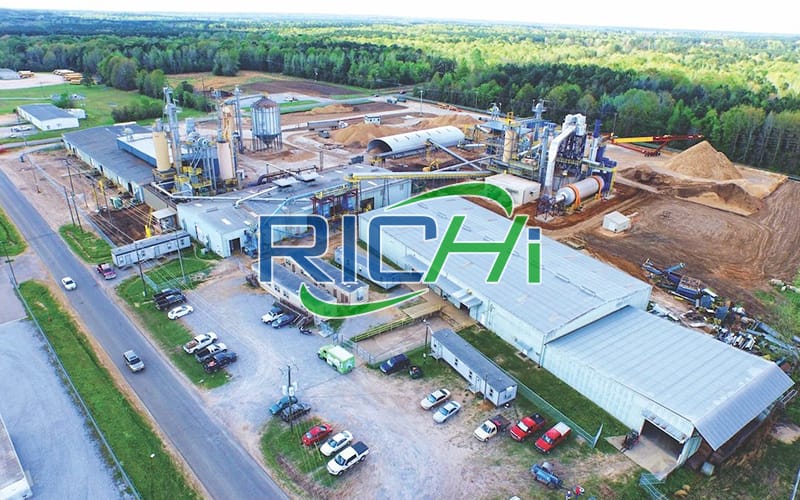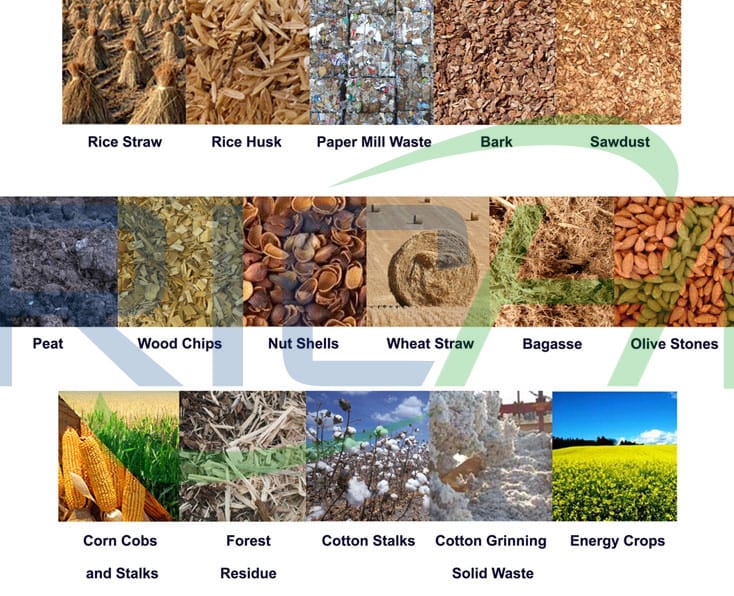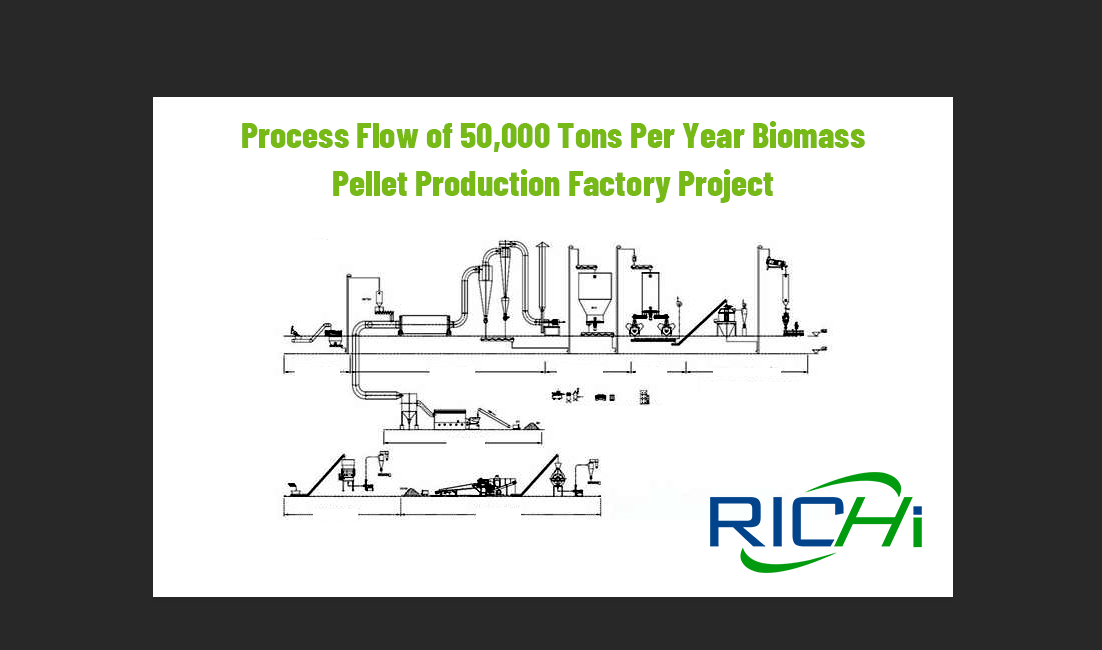Investment Proposal for Annual Production of 50,000 Tons Biomass Wood Branch Straw Bamboo Sawdust Pellet Production Line Project
Today I want to introduce to you a China large scale biomass energy pellet production line project built by RICHI in 2013. The following is the main content of RICHI's business investment proposal that supplied to our customers about complete 50,000 tons per year professional biomass agriculture waste wood straw bamboo branch pellet fuel production line project.

1. Project scale and construction conditions
(1) Total investment of this large capacity wood pellet production line project: 16.96 million yuan, of which: the first phase investment is 11.54 million yuan.
(2) Production scale: an annual output of 50,000 tons of biomass pellet fuel, a total of 2 production lines.
(3)Location: Zhejiang Province, China
(4)Raw material:Waste wood, waste bamboo,bamboo sawdust, straw, branches, etc.
2. Necessity of the annual output of 50,000 tons wood bamboo branch straw pellet making plant project
Currently, as a renewable resource, the storability of biomass energy and the characteristics of continuous energy conversion determine that biomass energy will become a very promising alternative energy source. Draw lessons from the current status of biomass energy utilization and research at home and abroad, combined with China’s national conditions, analyze the relationship between biomass energy and energy security, environmental security and food security, and formulate correct biomass energy development strategies, which are important for seeking economic and social, resource and environmental The path of sustainable development has important theoretical and practical significance.
After the completion of this project, this is not only to obtain returns for corporate investment, but more importantly, to actively participate in environmental protection, reduce dependence on petrochemical resources, increase sustainable development, and create an ecological urban environment and a conservation-oriented social mechanism atmosphere. After the completion of this project, it is expected to reduce 65,000 tons of carbon dioxide emissions and 25,000 tons of standard coal each year, which is fully in line with the basic requirements of the national development plan for related industries. It will better realize the integration of technology and social markets, effectively improve the quality of cities, change the face of the countryside, and expand urban and rural employment.

3. Market analysis of 50,000 tons/year biomass fuel wood bamboo branch straw pelletizing plant project
(1) Overview of the sales market
Producing biomass pellets, replacing traditional coal, firewood and other fuels, as fuels for various boilers and fuel heating devices, is currently relatively easy to achieve industrialized operations and create considerable economic benefits in a relatively short period of time Direction of development. Biomass pellets can be used as fuel for combustion equipment such as steam boilers, hot water boilers, organic heat carrier boilers, steam generators, fireplaces, etc. The manufacturing technology of the corresponding combustion equipment has been mature, and various biomass pellet making equipment are also widely available. Whether it is factories, hotels, hospitals, schools, bathing, catering, office buildings, etc., or industries such as food, chemical, printing and dyeing, heating, power generation, etc., biomass molding fuels can be used, and even ordinary households can also use them.
The principle and materials of combustion equipment using biomass briquettes as raw materials are the same as those of coal-fired combustion equipment, so the equipment prices are basically the same. In addition, traditional combustion equipment can be transformed into combustion equipment using biomass briquettes as raw materials. The use of biomass briquettes does not require repeated purchase of equipment. Regarding the biomass pellet fuel market, RICHI conducted a simple sample survey. The Zhejiang area sampled and surveyed the coal, oil, gas and other boiler units currently used by three customers. They all intend to use biomass pellets, and use biomass pellets every year. The fuel is about 30,000 tons. The result of this simple sample survey shows that the market sales of biomass pellet fuel is not a problem.
The ex-factory price of biomass wood chips (bamboo chips) pellets in China's domestic market is 1,000 yuan/ton for small packages (50 kg), and about 950 yuan/ton for large packages (tons); corn stalks (cotton stalks) The retail price of small packages of pellets is 450 yuan/ton, and the price of large packages is about 400 yuan/ton. In 2008, the purchase price of Japan and South Korea was about US$140-US$160/ton; the retail price of small packages in the US market was US$170/ton, and the price of large packages was about US$135/ton; the delivery price in Sweden was US$150 /Ton. The National Development and Reform Commission’s Biomass Briquette Development Plan proposes that by 2015, in combination with addressing rural basic energy needs and changing rural energy use methods, the construction of biomass pellet fuel application demonstration sites will be carried out to achieve annual consumption of 8 million tons of pellet fuel, replacing 5 million. Tons of coal. During the "Eleventh Five-Year Plan" period, the government will invest a lot of financial and manpower to promote biomass energy utilization technologies nationwide.
(2) Supply of raw materials:
①Utilize existing local resources: According to the statistics of Zhejiang Provincial Forestry Department, within 200 kilometers of each prefecture and city in the province and the surrounding area, we need biomass raw materials such as: urban garden pruning branches, forestry waste , Rotating branches, sawdust, urban decorations, wood processing plant waste, waste bamboo, rotating bamboo, etc., there will be more than 5 million tons per year. If 2% is recycled, there will be 100,000 tons of waste wood ( Branches) and moso bamboo. According to RICHI's market survey, at that time, each city in Zhejiang Province had an average of less than 1 biomass power plant and only 1 small pellet manufacturing plant. Therefore, at that stage, there would not be a situation of mutual snap-up and vicious bidding of biomass raw materials.
②Establish biomass fuel base: adopt contracting barren hills and wastelands, riverside beaches, tidal flat wastelands, inland river wetlands, etc. to plant fast-growing trees, which can not only help water and soil moisturizing, but also green the environment, and improve the role of climate change in preventing wind and sand fixation. At that time, RICHI inspected a number of fast-growing tree species such as poplar, eucalyptus, willow, bamboo and willow, etc. The highest annual biomass growth per hectare was 13 tons, 39 tons, 67 tons, and 150 tons. The material produced per mu is about 0.7 tons, 2.3 tons, 4.3 tons, and more than 10 tons.
Bamboo willow is a new variety of hybrid fast-growing willow. It is a deciduous tree with obvious central leading stem, straight body, strong top growth advantage, fewer lateral branches and small branch angles, and the crown is smaller than ordinary willows. It grows vigorously and fast, and is very suitable for high-density planting. It is an excellent tree species for establishing a biomass fuel base. The planting number per hectare reaches about 1 million (equivalent to 67,000 plants per acre-about 100 plants per square), and the growth per plant reaches more than 0.15 kg, and the growth per hectare will exceed 150 tons, equivalent to more than 10 tons per acre. Therefore, bamboo willow is more suitable as a species for ultra-short-term rotation coppice forest operation system. At the same time, a short rotation period makes it easier to ensure the frequency of production raw material supply, thereby increasing the utilization rate of biomass molding fuel production equipment and saving costs.
Bamboo willow is suitable for planting in most areas of China, and the suitable planting area covers almost the entire China. Bamboo and willow are water-resistant and resistant to saline and alkali, and a large number of unsuitable forests and barren hills, valleys, river beaches, river islands, river islands, coastal beaches, developable wetlands, artificial reservoir wetlands, seaside land, inland saline-alkali land, groundwater Marginal land such as higher sandy wasteland, mines, and oilfield reclamation land can be planted and used; under the conditions of pH 8.0-8.5 and salt content 14000ppm, it can grow normally. If the customer builds a biomass fuel base of more than 10,000 acre, it can provide more than 100,000 tons of bamboo and willow trees each year. Then, the raw materials required by customers are more secure.
4. The completely large 50,000 tons per year wood biomass pellets manufacturing plant production process

(1) Annual output 25,000 tons biomass pellet factory and infrastructure investment
| Name | Main content | Amount(RMB) |
| 15 acres of land acquisition | The land price per acre is 200,000 yuan | 3,000,000 |
| The main plant area is 2000 square meters | 1,000 yuan per square | 2,000,000 |
| Other facilities | Civil works, fences, water and electricity, office buildings, living, etc. | 1,130,000 |
Total |
/ | 6,130,000 |
(2) Investment of biomass wood bamboo straw pellet production plant equipments (the following is the investment in 1 wood pellet fuel production line)
| Name | Power(KW) | Amount(RMB) |
| Raw material receiving system | 16 | 179,520 |
| Rolling drying system | 217.5 | 726,000 |
| Hot blast stove system | 15.7 | 500,000 |
| Clinker receiving system | 33 | 203,120 |
| Biomass granulation system | 483 | 1,449,610 |
| Finished product processing and packaging system | 29.45 | 239,970 |
| Branch crushing system | 185.7 | 816,350 |
| Straw crushing system | 183.2 | 412,880 |
| Compressed air system | 11 | 34,500 |
| Other | / | 125,000 |
| Total cost of process equipment system | / | 359,845 |
| Electrical control system | / | 394,800 |
| Total | / | 5,411,595 |
6. Preliminary analysis of economic benefits (calculated based on 1 production line)
(1) Basic situation of the biomass wood pellet production line factory:
①Equipment production capacity: an annual output of 25,000 tons, 250 days of production, 20 hours of work per day (three shifts), and an average daily output of 100 tons.
②Factory staff: 20 operators per shift, totaling 60 people, workshop management staff: 3 mechanics, 1 statistical accounting staff, 1 assistant worker, 3 section chiefs, totaling 8 people. The total number of production personnel in the factory is 68.
☆According to the above manual calculation, if calculated at 40 yuan/person, the labor cost per ton of pellets is 28 yuan;
③Equipment energy consumption:
★Raw material receiving system: Equipment installed power: Around 16Kw.
★The installed power of equipment in the drying section (user-selected): Around 203Kw.
★Pelletizing section and finished product processing system, equipment installed power: Around 545.45Kw.
★Branches crushing section (configured according to 3t/h), equipment installed power: Around 185Kw.
★The straw crushing section (configured according to 5t/h), equipment installed power: Around 183Kw.
☆If the total power of producing straw is 710Kw, calculated according to the power coefficient of 0.75, its power consumption per ton of pellets is 145Kwh.
(2) Production cost of biomass (bamboo and wood) pellet fuel:
| Name | Unit Price(RMB) | Yuan/Ton |
| 1.Raw materials | Waste bamboo and wood 200 yuan (20% of the loss of freight) | 240 |
| 2. Factory cost | / | / |
| Utility bill | 0.90 yuan/Kwh (water charge) | 130 |
| Consumable parts | / | 30 |
| Labor cost | 5 yuan/hour | 28 |
| Equipment depreciation | / | 15 |
| Packaging costs | If you use tons of packaging to reduce costs | 20 |
| Total | / | 223 |
| 3. Comprehensive management costs | / | / |
| sales expense | Sale price 900 yuan×4% | 36 |
| Administrative costs | / | 15 |
| Financial expenses | / | 10 |
| Total | / | 57 |
| 4. Total cost | / | 520 |
| 5. Profit | Sales price 900 yuan/ton | 380 |
7. Relevant fee calculation standards:
(1) The price of raw materials: bamboo and wood materials are based on the current market price of 200 yuan, plus 20% of the freight and storage and transportation losses to the factory, and the average price to the factory is 240 yuan.
(2) Fuel and power costs: production electricity is calculated at 0.90 yuan/Kw, and consumption is estimated at production consumption. But the actual electricity price is only 0.75 yuan on average, so the water fee is included in this price.
(3) Equipment depreciation: Calculated according to relevant regulations, the depreciation period of fixed assets: 10 years for production houses and 5 years for machinery and equipment.
(4) Sales expenses: A commission is calculated based on 4% of the sales price of 900 yuan.
(5) Administrative expenses: including labor union expenses, social entertainment expenses, intangible asset amortization, deferred asset amortization, employee training expenses, other expenses, etc.; asset amortization is calculated according to relevant regulations, and intangible assets amortization is 10 Years, deferred assets amortization is based on 5 years; labor union funds are calculated based on 2% of the total wages; employee training expenses, office expenses, travel expenses and other expenses are calculated according to the actual situation of the enterprise.
(6) Financial expenses: including interest on working capital and other financial expenses.
8. Main economic and technical indicators
(1) The total investment of the project is 16.96 million RMB
(2) Annual production of 50,000 tons of material pellet fuel
(3) Annual sales revenue of 45 million yuan was realized
(4) Annual profit realized 19 million yuan
(5) Profit margin is 42.2%
(6) The payback period of investment is 1 year
(7) The annual return on investment is 89.3%
9. Conclusion
The industrial operation model proposed by RICHI for the "large production output 50,000 tons per year biomass fuel pellet plant for wood straw bamboo branch saudust pellet production project" was not available in other units at that time, and all links from raw materials to production and sales were very reasonable and reliable. Its economic and social benefits are even more significant, and it is a "short, flat and fast" investment project.
In order to quickly, healthy and long-term production of bio-energy residues, wood chips, bamboo chips, etc. in exchange for bamboo willow seedlings, this project will sign a long-term contract with farmers to buy back all the bamboo willow branches and trees produced, and provide free training for bamboo Willow planting technology. Bamboo willow seedlings are 2-5 yuan per plant, and more than 600 plants can be planted per acre.
If you want to built one complete pellet production line in your country, pls send the inquiry to us. We will customized design according to your requirement.



